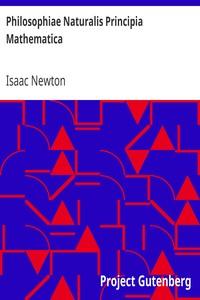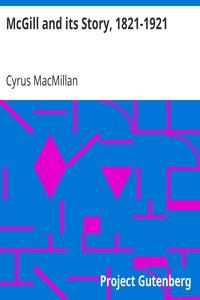Read this ebook for free! No credit card needed, absolutely nothing to pay.
Words: 17863 in 10 pages
This is an ebook sharing website. You can read the uploaded ebooks for free here. No credit cards needed, nothing to pay. If you want to own a digital copy of the ebook, or want to read offline with your favorite ebook-reader, then you can choose to buy and download the ebook.
llowed to embody the McGill crest with the artillery badge. It was organised as No. 6 Siege Battery, but after its arrival at the front it was known as No. 7 Battery, Canadian Siege Artillery. The Commanding Officer and the second in command were members of the teaching staff of the University; the other officers and non-commissioned officers were largely graduates, and more than half the gunners were McGill students. Because of rapid promotions and consequent transfers of officers and men, as well as of the usual circumstances and changes of war, this unit lost before the end of hostilities its distinctively McGill character. The majority of McGill men in the original unit received commissions. Five full companies of infantry and part of a sixth were recruited in the University. They were known as "The University Companies," and were sent to the front as reinforcements for the Princess Patricia's Canadian Light Infantry. The majority of the officers of these companies and a large number of the men were graduates or students of McGill. The 148th Battalion, Canadian Infantry, recruited in Montreal, although not under the authority of the University, was affiliated with the McGill Canadian Officers Training Corps, and a large number of its officers and men were members of that organization. Later, two reinforcement drafts were organized in the University and each contained a large proportion of students. One was a heavy artillery draft, which on arrival in England in the autumn of 1917 was absorbed into the artillery pool and was used to supply new siege artillery batteries about to be organised or to reinforce field and heavy batteries already at the front. The other draft was recruited for the Tank Battalion raised in the universities of Canada. But apart from the men in the units and drafts organized in the University, McGill men, students, graduates and professors, were found in practically every branch of the service, whether army or navy. The attendance of students in the University was reduced to a minimum; the teaching staff was depleted. In all, over twenty-five hundred McGill men enlisted. Three hundred and forty-one were killed in action, or died of wounds or disease; five hundred and twenty-two were wounded; three hundred and eighty-two received decorations or honours, two of which were the Victoria Cross. In recognition of its services in the allied cause the University received a grant of one million dollars from the Carnegie Foundation for the Advancement of Teaching. McGill's war record, tragic but glorious, is one of her proudest possessions.
Principal Peterson's health had been impaired even before the war by the cares of an active and busy life spent unsparingly in the interests and the advancement of the University. Like his predecessor, his life at McGill was one of unremitting labour and ceaseless, strenuous tasks which drew in the end a heavy toll from his strength. Then the war came. With its activities and the continuous demands it made upon his time and energy, it severely taxed his already weakened constitution. During the summer of 1918 he had been urged by his physicians and friends to rest because of his failing health. He did not heed the advice; he felt, indeed, that he could not in that troubled and anxious time obey it. He refused to curtail his exertions, and he continued to give his great ability and his unstinted service in every way to help the allied cause. On Sunday, the 12th of January, 1919, although he was not then in good health, he presided at a meeting on behalf of a fund for the benefit of the dependents of Scottish soldiers and sailors killed or disabled in the war. While the meeting was in progress he was stricken with apoplexy and partial paralysis. In the course of a few weeks he recovered his speech almost entirely, and later he regained the partial use of his right leg. When it became evident that he could not recover sufficiently to resume his place at the head of the University he resigned, and after May 1st he ceased to be Principal of McGill. On July the 24th he sailed from Montreal for England, where he resided until his death in February, 1921.
Sir William Peterson was Principal of McGill University for a period of twenty-four years, one quarter of its century of life. During that time many honours came to him. He occupied the presidency of many learned societies; he was knighted in 1915; he received honorary degrees from the leading universities of Britain, America and Canada; he was Chairman of the Board of Trustees of the Carnegie Foundation for the Advancement of Teaching; he won great distinction as a scholar and a writer. It would be unwise here to attempt to estimate the significance of his work as Principal of the University. We are perhaps too close to judge it with correctness or with justice. The McGill he left in 1919 was not the McGill he found in 1895. In the intervening years its development on the sure foundations that had already been laid was extraordinary and unprecedented for a university. Among the external evidences of growth during that time are the McGill Union, the centre of student activities; the Conservatorium of Music, with courses leading to the degree of Bachelor and Doctor of Music; the establishment of a Department of Dentistry, now grown to the stature of a Faculty; the acquisition of the Joseph property at the southwest corner of the Yard, and the new Molson and Law properties, consisting of 25 acres, the site of the Molson Stadium, and of the gymnasium and student residences of the future; the new Medical building; the establishment and development of the Graduate School, and of the Departments of Commerce, Social Service and Physical Education, and above all, the addition of Macdonald College with its vast acres at Ste. Anne de Bellevue, where the work of the Faculty of Agriculture, Household Science and the training of teachers is carried on. In these twenty-five years the number of students more than doubled. Financially, too, there was a change. In 1895 endowments amounted to over a million and a half of dollars, in 1919 they were over twelve millions, a sum to which the citizens' response to the appeal for funds in 1911 largely contributed; the income in 1895 was two hundred thousand dollars and the disbursements one hundred and eighty thousand; in 1919 the income and disbursements each amounted to approximately one million dollars. In addition to these visible evidences of progress many new and improved courses were established; the teaching staff was greatly increased, and the reputation of the University was enhanced at home and abroad. Externally and internally the newer and greater McGill bears testimony to the energy and determination of Sir William Peterson during his twenty-four years' occupancy of the Principalship. With the criticisms of his administration--that as Principal Sir William was an Imperialist first and afterwards a Canadian, and that in making professorial appointments he did not often consider Canadian scholars, with at least equal qualifications--we are not here concerned.
In May, 1920, Sir Arthur Currie, formerly Commander of the Canadian Corps in France, was appointed Principal, and in the following August he took up his new duties. In June of that year Vice-Principal Moyse resigned after forty-one years of service as Professor of English. He was succeeded as Vice-Principal by Dr. Frank D. Adams, Dean of the Faculty of Applied Science.
One of the first acts of the new Principal was the making of a general appeal, with the Governors, in the autumn of 1920, for public subscriptions to increase the endowment fund and revenues for the purpose of increasing professors' salaries and for the erection of new buildings or extensions. The response to this appeal was generous; a sum of over six million dollars was subscribed, of which one million was from the Province of Quebec. The renewed interest of graduates in their University was evidenced by the fact that they subscribed over half the amount raised. As a result of the increased endowment, two structures were at once undertaken, one an extension to the Library, and the other a new building for the Medical Faculty.
With an encouraging interest in its welfare by graduates and by citizens, with a large increase in students who last year numbered over three thousand, with forward face looking hopefully to the future, McGill University has rounded out its first century of life. The road over which it has passed, as we look back from the hilltop of to-day, has been long and arduous. It has been beset with many trials and difficulties. But the obstacles in the way of its advance were not unsurmountable; they were perhaps objects of discouragement, but never objects of total despair to the men of stout heart and firm faith and far-off vision who made McGill.
Free books android app tbrJar TBR JAR Read Free books online gutenberg
More posts by @FreeBooks


: Philosophiae Naturalis Principia Mathematica by Newton Isaac - Mechanics Early works to 1800; Celestial mechanics Early works to 1800 Best Books Ever Listings; Mathematics; Physics









